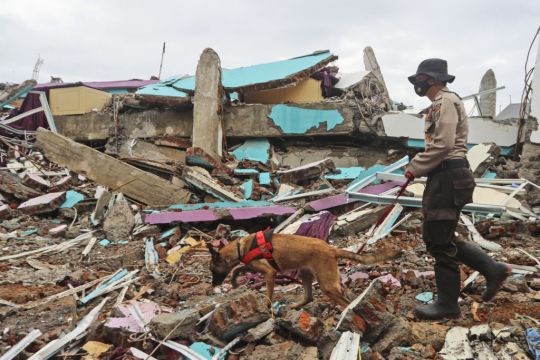Indonesian rescuers have retrieved more bodies from the rubble of homes and buildings toppled by a strong earthquake, raising the death toll to 78, while military engineers have managed to reopen ruptured roads to clear access for relief goods.
More heavy equipment reached the hardest-hit city of Mamuju and the neighbouring district of Majene on Sulawesi island, where the magnitude 6.2 quake struck early on Friday, Raditya Jati, the National Disaster Mitigation Agency’s spokesperson, said.
A total of 67 people died in Mamuju and 11 in Majene, the director of preparedness for the National Search and Rescue Agency, Didi Hamzar, said.

Power supplies and phone communications had begun to improve in the quake areas.
Thousands of people were left homeless and more than 800 were injured, with more than half of them still receiving treatment for serious injuries, Mr Jati said.
The disaster agency’s data showed that nearly 27,850 survivors were moved to shelters. Most of them went to makeshift shelters that have been lashed by heavy monsoon downpours. Only a few were protected by tarpaulin-covered tents.
They said they were running low on food, blankets and other aid, as emergency supplies were rushed to the hard-hit region.

“We are unable to return to our destroyed homes,” said a father-of-three who identified himself only as Robert.
He said he fled from his bed while being treated at Mamuju’s Mitra Manakarra hospital, which was flattened by the quake. He and his family are among thousands of displaced people who took shelter in a hilly area.
He said his bed was shaking when he awoke and he realised it was an earthquake. He then removed a drip from his hand and ran out. He had seen several nurses helping patients who were unable to move before the building collapsed.
“I cried when I saw the hospital where I was being treated collapse with people still inside. I could have died if I got out late,” he said.

Rescuers managed to retrieve four survivors and four bodies from the rubble of the flattened hospital, according to the Search and Rescue Agency.
Mr Jati said that at least 1,150 houses in Majene were damaged and that the agency was still collecting data on damaged houses and buildings in Mamuju.
Mamuju, the provincial capital of nearly 300,000 people, was strewn with debris from collapsed buildings. The governor’s office building was almost flattened by the quake and a shopping mall was reduced to a crumpled hulk.
The disaster agency said the army corps of engineers had cleared the road connecting Mamuju and Majene that had been blocked by landslides. They had also rebuilt a damaged bridge.
The disaster agency’s chief, Doni Monardo, said authorities were trying to separate higher and lower-risk groups and provided tens of thousands of masks for refugees to prevent the spread of coronavirus in the crowded camps. He said authorities would also set up health posts at the camps to test people for the virus.

People being housed in temporary shelters were seen standing close together, many of them without masks.
“In this emergency situation … it is difficult for us to observe health protocols,” said Fatimah Zahra, a Mamuju resident who had moved to a makeshift shelter.
West Sulawesi province has recorded more than 2,500 cases of coronavirus, including 58 deaths. Indonesia has confirmed nearly 908,000 cases and almost 26,000 fatalities.
Many on Sulawesi island are still haunted by a magnitude 7.5 earthquake that devastated Palu city in 2018 and set off a tsunami that caused soil to collapse in a phenomenon called liquefaction. More than 4,000 people were killed, including many who were buried when
whole neighbourhoods were swallowed in the falling ground.
Indonesia, home to more than 260 million people, is frequently hit by earthquakes, volcanic eruptions and tsunamis because of its location on the “Ring of Fire”, an arc of volcanoes and fault lines in the Pacific Basin.
A massive magnitude 9.1 earthquake off Sumatra island in western Indonesia in December 2004 triggered a tsunami that killed 230,000 people in a dozen countries.







